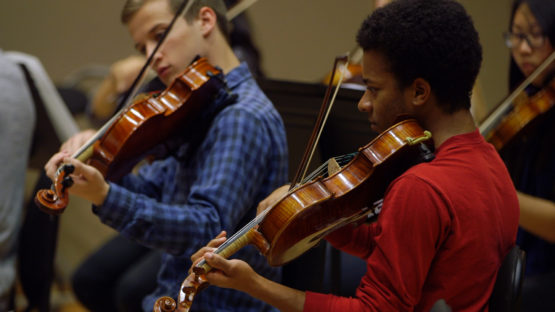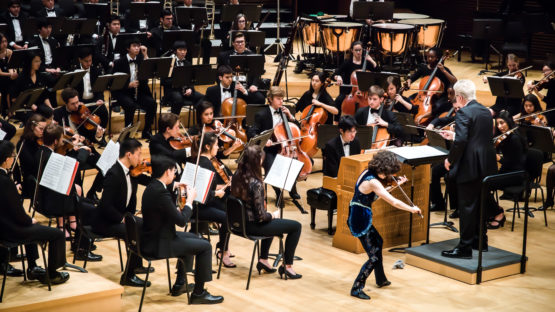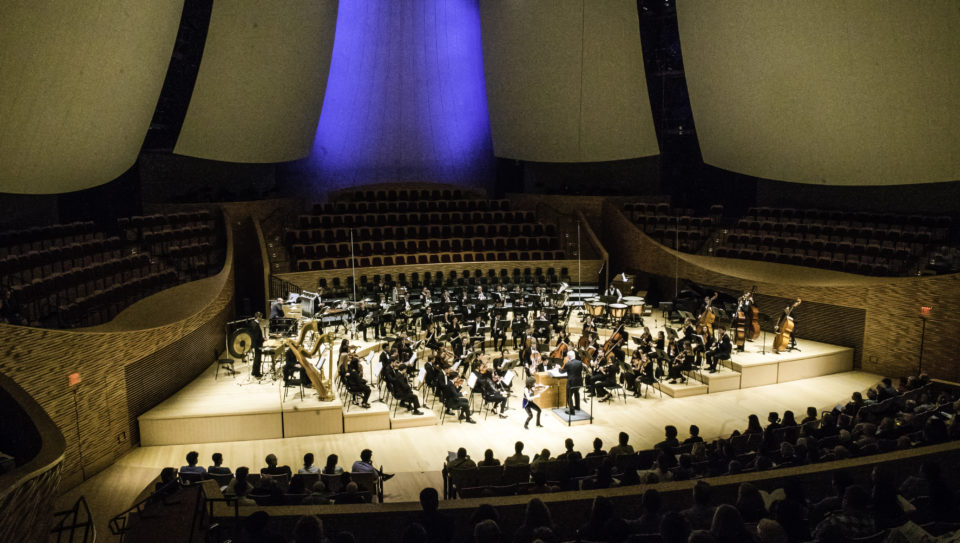Stanford students play leading role in first U.S. performances of Elfman’s Concerto for Violin and Orchestra
In anticipation of the Stanford Symphony Orchestra’s performance of Concerto for Violin and Orchestra: Eleven Eleven, students had the rare opportunity to work closely with its prominent composer, Danny Elfman.
“Great concentration, great job and great work,” composer Danny Elfman said, complimenting Stanford student musicians after a run-through of his Concerto for Violin and Orchestra: Eleven Eleven.
Go to the web site to view the video.
In anticipation of Stanford Symphony Orchestra’s March 10 and 11 performances of his concerto at Bing Concert Hall, Elfman spent two days fine-tuning the orchestration of his score – stronger brass here, softer strings there.
“It’s been really cool just to see Danny Elfman saying, ‘OK, at this moment, I need more percussion,’” said violist Jenny Yang, a junior majoring in materials science and engineering. “You can definitely hear a lot of elements of what you hear in his scores in this concerto.”
Elfman is best known for his work in film, particularly for collaborating with director Tim Burton on movies including The Nightmare Before Christmas and Batman. He has composed more than 100 film scores and has been nominated for four Academy Awards. He also created the iconic theme music for The Simpsons and was a founding member of the band Oingo Boingo.
Members of the Stanford Symphony Orchestra (SSO) were the first musicians in the United States to play Elfman’s Concerto for Violin and Orchestra. The piece was jointly commissioned by Stanford Live, Stanford University, the Czech National Symphony Orchestra and the Royal Scottish National Orchestra. It premiered in Prague in 2017.

Danny Elfman and John Mauceri give notes to students of Stanford Symphony Orchestra during rehearsal. (Image credit: Kurt Hickman)
“This is by far the hardest thing I’ve ever worked on,” Elfman said of his first violin concerto.
Upon receiving the commission, Elfman worked closely with violin virtuoso Sandy Cameron to better understand what the instrument could do, just as celebrated composers Shostakovich, Brahms and Tchaikovsky had leaned on the expertise of instrumentalists.
One of the challenges for Elfman was balancing a big sound from the orchestra with a more nuanced one from Cameron, who delivered the dynamic solo role at the Stanford Live premiere.
“I love sounding big,” Elfman said.
Fortunately, Elfman had 75 members of SSO, the largest on-campus student music organization, to help him. The concerto provided complex material for the students, who relished the invitation to play alongside world-class artists.
SSO violinist Tara Iyer, a junior majoring in computer science, said she was amazed by Cameron’s execution of the “monster violin part” in Elfman’s score.

Members of Stanford Symphony Orchestra rehearse Danny Elfman’s Concerto for Violin and Orchestra in the Bing Concert Hall Studio. (Image credit: Kurt Hickman)
“It contains every crazy, technical thing you could possibly do on the violin,” said Iyer. “She draws out such an incredible range of emotions from the piece, and her playing is flawless, so it’s pretty exciting to get to accompany her.”
The student experience – to learn while performing at a high level – is a tenet of Stanford Live’s programming. “One of the things we’ve focused on is bringing a diverse range of artists to campus and have students, faculty and the community interact with them,” said Chris Lorway, executive director of Stanford Live and Bing Concert Hall. He engaged Elfman to give students the rare opportunity to work with the prominent composer and to learn firsthand how he constructed the violin concerto.
“It provides a whole other level of insight for students that they don’t necessarily get when interpreting the works of those no longer with us,” Lorway said.

Guest artists Sandy Cameron and Paul Mauceri join students at Bing Concert Hall. (Image credit: Azar Kafaei)
As with many classical music ensembles, SSO’s repertory is grounded in works composed before the mid-20th century. Elfman took careful notes and adjusted his score’s orchestration during rehearsals, challenging students with new lines on the spot and relying on their performance to strike just the right tune.
“It feels like we’re actually helping him to create the final version,” said SSO music director and conductor Paul Phillips.
The feeling is mutual: Elfman agreed the violin concerto was still a work in progress but Stanford students played a valuable role, incorporating new bits of orchestration into the piece. “Depending on how much time I have, I’d make hundreds of changes. It’s a really difficult piece to get through,” he said. “I really saw that the students had arrived prepared, and so I’m very happy with the results.”
The Stanford Live program, presented in partnership with Music at Stanford, also included Leonard Bernstein’s On the Waterfront – Symphonic Suite and, with Stanford Symphonic Chorus and Stanford University Singers, William Walton’s Belshazzar’s Feast. Stanford Symphony Orchestra is supported by the Department of Music and the Associated Students of Stanford University (ASSU).

